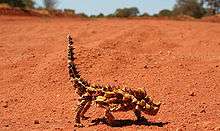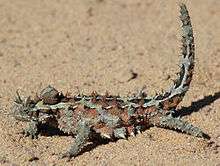Thorny devil
The thorny devil (Moloch horridus), also known commonly as the mountain devil, thorny lizard, thorny dragon, and moloch, is a species of lizard in the family Agamidae. The species is endemic to Australia. It is the sole species in the genus Moloch. It grows up to 21 cm (8.3 in) in total length (including tail), with females generally larger than males.
| Moloch horridus | |
|---|---|
 | |
| Scientific classification | |
| Kingdom: | Animalia |
| Phylum: | Chordata |
| Class: | Reptilia |
| Order: | Squamata |
| Suborder: | Iguania |
| Family: | Agamidae |
| Subfamily: | Amphibolurinae |
| Genus: | Moloch Gray, 1841 |
| Species: | M. horridus |
| Binomial name | |
| Moloch horridus Gray, 1841 | |
 | |
| Synonyms | |
|
Acanthosaura gibbosus | |
Taxonomy
The thorny devil was first described by the biologist John Edward Gray in 1841. While it is the only species contained in the genus Moloch, many taxonomists suspect another species might remain to be found in the wild.[1] The thorny devil is only distantly related to the morphologically similar North American horned lizards of the genus Phrynosoma. This similarity is usually thought of as an example of convergent evolution.
The names given to this lizard reflect its appearance: the two large horned scales on its head complete the illusion of a dragon or devil. The name Moloch was used for a deity of the ancient Near East, usually depicted as a hideous beast.[2] The thorny devil also has other nicknames people have given it such as the "devil lizard", "horned lizard", and the "thorny toad".[3]
Description
The thorny devil grows up to 21 cm (8.3 in) in total length (including tail),[4] and can live for 15 to 20 years. The females are larger than the males. Most specimens are coloured in camouflaging shades of desert browns and tans. These colours change from pale colours during warm weather to darker colours during cold weather. The thorny devil is covered entirely with conical spines that are mostly uncalcified.

An intimidating array of spikes covers the entire upper side of the body of the thorny devil. These thorny scales also help to defend it from predators. Camouflage and deception may also be used to evade predation. This lizard's unusual gait involves freezing and rocking as it moves about slowly in search of food, water, and mates.[1]
The thorny devil also features a spiny "false head" on the back of its neck, and the lizard presents this to potential predators by dipping its real head. The "false head" is made of soft tissue.[5]
The thorny devil's scales are ridged, enabling the animal to collect water by simply touching it with any part of the body, usually the limbs; the capillary principle allows the water to be transported to the mouth through the skin.[1]
Distribution and habitat


The thorny devil usually lives in the arid scrubland and desert that covers most of central Australia, sandplain and sandridge desert in the deep interior and the mallee belt.
The habitat of the thorny devil coincides more with the regions of sandy loam soils than with a particular climate in Western Australia.[6]
Self-defense
The thorny devil is covered in hard, rather sharp spines that dissuade attacks by predators by making it difficult to swallow. It also has a false head on its back. When it feels threatened by other animals, it lowers its head between its front legs, and then presents its false head. Predators that consume the thorny devil include wild birds and goannas.
Diet
The thorny devil mainly subsists on ants, especially Ochetellus flavipes and other species in the Iridomyrmex or Ochetellus genera.[7] Thorny devils often eat thousands of ants in one day.[1]
The thorny devil collects moisture in the dry desert by the condensation of dew. This dew forms on its skin in the early morning as it begins to warm outside. Then the dew is channeled to its mouth in hygroscopic grooves between its spines.[8] During rainfalls, capillary action allows the thorny devil to absorb water from all over its body. Capillary action also allows the thorny devil to absorb water from damp sand. Absorption through sand is the thorny devils main source of water intake.[9]
Reproduction
The female thorny devil lays a clutch of three to ten eggs between September and December. She puts these in a nesting burrow about 30 cm underground. The eggs hatch after about three to four months.[10]
Popular reference
The popular appeal of the thorny devil is the basis of an anecdotal petty scam. American servicemen stationed in Southwest Australia decades ago (such as during World War II) were supposedly sold the thorny fruits of a species of weeds, the so-called "double gee" (Emex australis), but those were called "thorny devil eggs" as a part of the scam. Thorny devils have been kept in captivity.[1]
References
- Browne-Cooper, Robert; Bush, Brian; Maryan, Brad; Robinson, David (2007). Reptiles and Frogs in the Bush: Southwestern Australia. University of Western Australia Press. pp. 46, 65, 158. ISBN 978-1-920694-74-6.
- Beolens, Bo; Watkins, Michael; Grayson, Michael (2011). "Moloch horridus" in The Eponym Dictionary of Reptiles. Baltimore: Johns Hopkins University Press. p. 182. ISBN 978-1-4214-0135-5.
- Thorny Devil Lizard – Prickly Desert Ant-Eater. factzoo.com
- Boulenger GA (1885). "Moloch horridus" in Catalogue of the Lizards in the British Museum (Natural History). 2nd Ed. Vol. I. ... Agamidæ.. Taylor and Francis. pp. 411–412.
- Bell, Christopher; Mead, Jim; Swift, Sandra (2009). "Cranial osteology of Moloch horridus (Reptilia: Squamata: Agamidae)". Records of the Western Australian Museum. 25 (Part 2): 201–237. doi:10.18195/issn.0312-3162.25(2).2009.201-237.
- Pianka ER, Pianka HD (1970). "The ecology of Moloch horridus (Lacertilia: Agamidae) in Western Australia". Copeia. 1970 (1): 90–103. doi:10.2307/1441978. JSTOR 1441978.
- Australia's Thorny Devil, retrieved 31 October 2007
- Bentley PJ, Blumer FC (1962). "Uptake of water by the lizard, Moloch horridus". Nature. 194 (4829): 699–700. Bibcode:1962Natur.194..699B. doi:10.1038/194699a0. PMID 13867381. S2CID 4289732.
- Knight, Kathryn (2016). "How thorny devils tap damp sand to slake thirst". The Journal of Experimental Biology. 219 (21): 3309.1–3309. doi:10.1242/jeb.151407. S2CID 89521720.
- Pianka ER (1997). "Australia's thorny devil". Reptiles. 5 (11): 14–23.
Further reading
- Clemente, Christofer; Thompson, Graham G.; Withers, Philip C; Lloyd, David (2004). "Kinematics, maximal metabolic rate, sprint and endurance for a slow-moving lizard, the thorny devil (Moloch horridus)". Australian Journal of Zoology. 52 (5): 487–503. doi:10.1071/ZO04026.
- Meyers, Jay (2005). "Prey capture kinematics of ant-eating lizards". Journal of Experimental Biology. 208 (Pt 1): 115–127. doi:10.1242/jeb.01345. PMID 15601883. ProQuest 13293724.
- Cogger HG (2014). Reptiles and Amphibians of Australia, Seventh Edition. Clayton, Victoria, Australia: CSIRO Publishing. xxx + 1,033 pp. ISBN 978-0643100350.
- Gray JE (1841). "Description of some new Species and four Genera of Reptiles from Western Australia discovered by John Gould, Esq." The Annals and Magazine of Natural History, [First Series ] 7: 86–91. (Moloch, new genus pp. 88–89; M. horridus, new species, p. 89).
- Wilson, Steve; Swan, Gerry (2013). A Complete Guide to Reptiles of Australia, Fourth Edition. Sydney: New Holland Publishers. 522 pp. ISBN 978-1921517280.
External links
| Wikimedia Commons has media related to Moloch horridus. |
